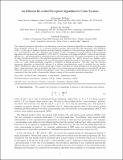An Efficient Rescaled Perceptron Algorithm for Conic Systems
Author(s)
Vempala, Santosh; Belloni, Alexandre; Freund, Robert Michael
DownloadFreund_An Efficent Re-ScaledPerceptronConic-Accepted-JAN09.pdf (361.1Kb)
OPEN_ACCESS_POLICY
Open Access Policy
Creative Commons Attribution-Noncommercial-Share Alike
Terms of use
Metadata
Show full item recordAbstract
The classical perceptron algorithm is an elementary row-action/relaxation algorithm for solving a homogeneous linear inequality system Ax > 0. A natural condition measure associated with this algorithm is the Euclidean width {tau} of the cone of feasible solutions, and the iteration complexity of the perceptron algorithm is bounded by 1/{tau}2 [see Rosenblatt, F. 1962. Principles of Neurodynamics. Spartan Books, Washington, DC]. Dunagan and Vempala [Dunagan, J., S. Vempala. 2007. A simple polynomial-time rescaling algorithm for solving linear programs. Math. Programming 114(1) 101–114] have developed a rescaled version of the perceptron algorithm with an improved complexity of O(n ln (1/{tau})) iterations (with high probability), which is theoretically efficient in {tau} and, in particular, is polynomial time in the bit-length model. We explore extensions of the concepts of these perceptron methods to the general homogeneous conic system Ax isin int K, where K is a regular convex cone. We provide a conic extension of the rescaled perceptron algorithm based on the notion of a deep-separation oracle of a cone, which essentially computes a certificate of strong separation. We show that the rescaled perceptron algorithm is theoretically efficient if an efficient deep-separation oracle is available for the feasible region. Furthermore, when K is the cross-product of basic cones that are either half-spaces or second-order cones, then a deep-separation oracle is available and, hence, the rescaled perceptron algorithm is theoretically efficient. When the basic cones of K include semidefinite cones, then a probabilistic deep-separation oracle for K can be constructed that also yields a theoretically efficient version of the rescaled perceptron algorithm.
Date issued
2009-08Department
Sloan School of ManagementJournal
Mathematics of Operations Research
Publisher
Institute for Operations Research and the Management Sciences (INFORMS)
Citation
Belloni, Alexandre, Robert M Freund, and Santosh Vempala. “An Efficient Rescaled Perceptron Algorithm for Conic Systems.” MATHEMATICS OF OPERATIONS RESEARCH 34.3 (2009): 621-641. ©2009 INFORMS.
Version: Author's final manuscript
ISSN
1526-5471
0364-765X
Keywords
Separation oracle, Conic system, Perception, Convex cones